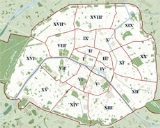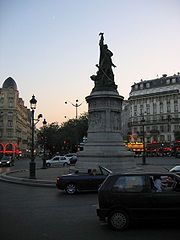
Place de Clichy
Encyclopedia

Boulevard de Clichy
The Boulevard de Clichy , which lends its name to the Place de Clichy, resulted from the fusion, in 1864, of the roads that paralleled the Wall of the Farmers-General, both inside and out. It extends from the Place de Clichy to the Rue des Martyrs, nearly a kilometre away...
, the Avenue Clichy, the Rue Clichy, the Boulevard des Batignolles
Batignolles
Batignolles is a neighborhood of Paris, a part of the 17th arrondissement of the city. The neighborhood is bounded on the south by the Boulevard des Batignolles, on the east by the Avenue de Clichy, on the north by the Rue Cardinet, and on the west by the Rue de Rome.-History:Batignolles was an...
, and the Rue d'Amsterdam.
It lies at the former site of the barrière de Clichy, an ancient portal in the Wall of the Farmers-General
Wall of the Farmers-General
The Wall of the Farmers-General was built between 1784 and 1791 by the Ferme générale, the corporation of tax farmers. It was one of the several city walls of Paris built between the early Middle Ages to the mid 19th century. It was 24 kilometers long and roughly followed the route now occupied by...
, leading to the village of Clichy
Clichy, Hauts-de-Seine
-Administration:The canton covers a part of the commune; the other is in the northern part of Levallois-Perret-Twinnings: Heidenheim, Germany, since 1959 Sankt Pölten, Austria, since 1968 Santo Tirso, Portugal, since 1991 Rubí, Spain, since 2005 Southwark, United Kingdom, since 2005Clichy has also...
, outside the wall.
Description
The Place de Clichy is one of the few places in Paris where four arrondissements (the 8th, 9th, 17th, and 18th) meet at a single point. (The others are the Pont Saint-MichelPont Saint-Michel
Pont Saint-Michel is a bridge linking the Place Saint-Michel on the left bank of the river Seine to the Île de la Cité. It was named after the nearby chapel of Saint-Michel. It is near Sainte Chapelle and the Palais de Justice...
, where the 1st, 4th, 5th, and 6th meet, and the Belleville
Belleville, Paris
Belleville is a neighbourhood of Paris, France, parts of which lie in four different arrondissements. The major portion of Belleville straddles the borderline between the 20th arrondissement and the 19th along its main street, the Rue de Belleville...
roundabout, where the 10th, 11th, 19th and 20th come together.)
The Place de Clichy is also unusual in that it has been untouched by urban planners. This explains the heterogeneous façades of the buildings in the area. The Place de Clichy has the character of a substantial crossroads, rather than that of a real place (public square).
Surrounding the Place de Clichy is a lively array of shops, restaurants, and businesses, including a popular cinema. It is a hive of activity, both day and night.
History
In March 1814, at the close of the First French EmpireFirst French Empire
The First French Empire , also known as the Greater French Empire or Napoleonic Empire, was the empire of Napoleon I of France...
, 800,000 soldiers of various foreign armies marched on Paris. After breaking through the barriers at Belleville and Pantin
Pantin
Pantin is a commune in the northeastern suburbs of Paris, France. It is located from the center of Paris. It is one of the most densely populated municipalities in Europe. Its post code is 93500.Pantin was once the site of Motobecane's operations...
, they took the hill of Montmartre
Montmartre
Montmartre is a hill which is 130 metres high, giving its name to the surrounding district, in the north of Paris in the 18th arrondissement, a part of the Right Bank. Montmartre is primarily known for the white-domed Basilica of the Sacré Cœur on its summit and as a nightclub district...
. Paris was protected in the north from Clichy
Clichy, Hauts-de-Seine
-Administration:The canton covers a part of the commune; the other is in the northern part of Levallois-Perret-Twinnings: Heidenheim, Germany, since 1959 Sankt Pölten, Austria, since 1968 Santo Tirso, Portugal, since 1991 Rubí, Spain, since 2005 Southwark, United Kingdom, since 2005Clichy has also...
to Neuilly
Neuilly-sur-Seine
Neuilly-sur-Seine is a commune in the western suburbs of Paris, France. It is located from the center of Paris.Although Neuilly is technically a suburb of Paris, it is immediately adjacent to the city and directly extends it. The area is composed of mostly wealthy, select residential...
, by 70,000 men of the garde nationale
National Guard (France)
The National Guard was the name given at the time of the French Revolution to the militias formed in each city, in imitation of the National Guard created in Paris. It was a military force separate from the regular army...
. In the face of the advancing enemy, the Maréchal de Moncey defended the barrière de Clichy. Moncey amassed 15,000 volunteers, tirailleur
Tirailleur
Tirailleur literally means a shooting skirmisher in French from tir—shot. The term dates back to the Napoleonic period where it was used to designate light infantry trained to skirmish ahead of the main columns...
s — students from the École polytechnique
École Polytechnique
The École Polytechnique is a state-run institution of higher education and research in Palaiseau, Essonne, France, near Paris. Polytechnique is renowned for its four year undergraduate/graduate Master's program...
and the École vétérinaire
École nationale vétérinaire d'Alfort
The École nationale vétérinaire d'Alfort is a school of veterinary medicine located at 7, avenue du Général de Gaulle, Maisons-Alfort, Val-de-Marne, Île-de-France, France...
— and, despite their inexperience, valiantly resisted the Russian contingent until an armistice was declared on 30 March 1814.
Monument
A six-metre-tall bronze statue, executed by Amédée Doublemard and dedicated to de Moncey, stands on an ornate pedestal eight metres tall.Metro station
The Place de Clichy is:It is served by lines 2 and 13.


See also
- Régie Autonome des Transports Parisiens (RATP/Autonomous Operator of Parisian Transports)
- Tramways in ParisTramways in ParisThe French region of Île-de-France, encompassing the capital city of Paris, currently has four tram lines, and is planning an additional line. Of the existing lines, three are operated by its public transport authority, RATP, which also operates the Paris Métro and most bus services. The fourth...

